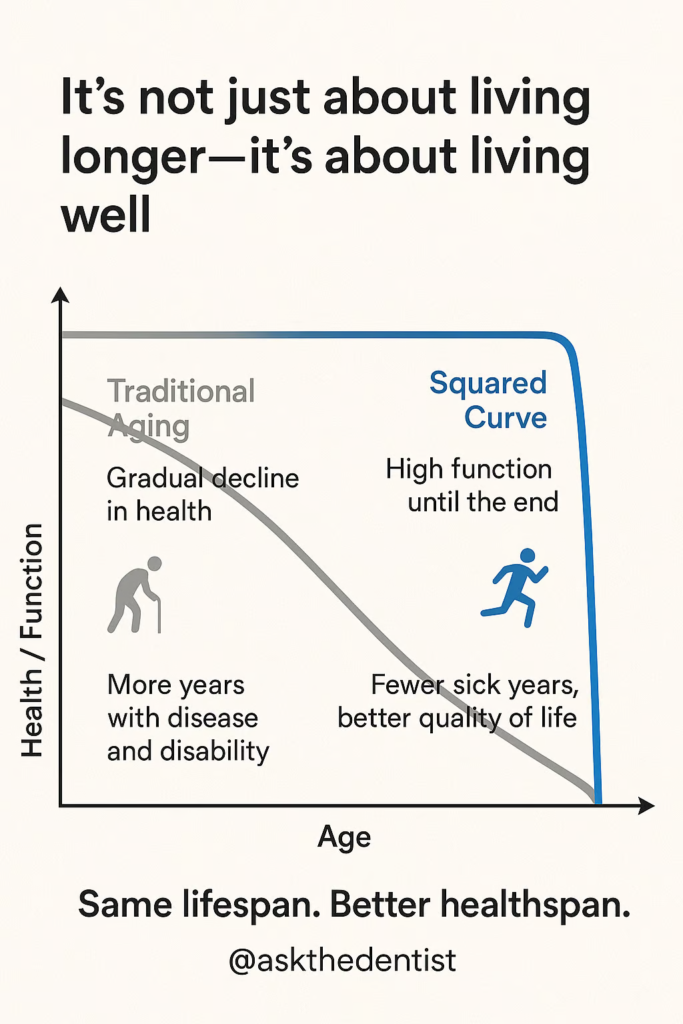When I was younger, longevity meant adding years.
Today, it means adding life to those years.
This month, I turned 66. And instead of slowing down, I’m doubling down—on my health, my energy, and my strength.
My wife and I still ski. We mountain bike. We chase our grandkids around the house. I’m not trying to survive into my 90s—I want to thrive once I’m there.
Because I’ve seen the other side. Both my parents had Alzheimer’s. My in-laws lived into their 90s, but they were frail, dependent, and barely able to move. That’s not aging. That’s slow dying.
My goal? To square the life curve. To feel healthier in my 60s than I did in my 30s.
Longevity Science in 9 Quick Hits
- Heart risk jumps when gums bleed.
41 systematic reviews find periodontitis raises cardiovascular disease risk 19‑36 % depending on severity. (BioMed Central) - Tooth loss shaves off healthy brain years.
2024 meta‑analysis ties poor periodontal health to a 34 % higher chance of cognitive impairment. (SpringerLink) - More teeth = more life.
Adults keeping ≥20 teeth at 70 enjoy longer disability‑free life expectancy than those with ≤19. (The Lancet) - Inflammation drops when you treat gums.
Intensive scaling + azithromycin cut CRP and TNF‑α for six months in people with metabolic syndrome. (Frontiers) - Pregnancy outcomes depend on maternal plaque control.
Periodontitis raises pre‑eclampsia risk 2.17× and low‑birth‑weight risk 1.65×. (Fetal Medicine Foundation) - Blood‑pressure help starts on your tongue.
Nitrate‑reducing oral bacteria restore nitric oxide when NOS declines with age, supporting vascular health. (Frontiers) - Sleep apnea hits cognition—especially in women.
Ten‑year cohort of 18,815 adults links obstructive sleep apnea to a 4.7 % higher dementia incidence in women by 80. (Health) Airway shape, tongue posture, and oral inflammation all influence OSA risk. - Poor oral hygiene pairs with higher all‑cause mortality.
Front‑line cohort data: edentulous adults show the steepest survival drop. (Frontiers) - Popular press is catching up.
Even Business Insider now headlines the oral microbiome as a longevity tool. (Business Insider)
What Does It Mean to Square the Life Curve?
“Squaring the curve” doesn’t just mean living longer—it means staying healthy until the very end.
Instead of a long, slow decline into disease and disability, the goal is to compress sickness into the shortest possible window before death. Imagine a graph of health over time: rather than a gradual slope downward, the ideal curve stays flat—high function, high quality of life—then drops off sharply at the end. It’s not about adding years to your life, but life to your years.
Because what’s the point of living longer if you’re not living well?
Most people age like this: A slow, steady decline in muscle, energy, and brain power. More prescriptions, more falls, less autonomy.
But it doesn’t have to go that way.
When you square the life curve, you stay sharp and mobile until the very end. You don’t just extend lifespan—you extend healthspan.
The brain changes that lead to Alzheimer’s at 75? They start at 40.
The strength you’ll need to get off the floor at 85? You’re building—or losing—that today.
Here’s what I’m doing now to stay in the “square.”
1. I Prioritize My Mitochondria—Because They Are the Aging Clock
If your mitochondria break down, so does your brain, your heart, your gums—everything.
Here’s my current protocol:
- C15:0 (pentadecanoic acid): An odd-chain saturated fat you’re probably not getting from your diet. Backed by strong human data. Supports mitochondrial function and lowers inflammation. This is the one I take.
- CoQ10: Crucial for cellular energy and brain-heart health, especially if you’re on statins. This is the one I take.
- Magnesium: For energy, brain function, and deep sleep. This is the one I take.
2. I Protect My Brain—Starting With My Mouth
Both of my parents had Alzheimer’s. I’ve spent 40+ years connecting the dots between oral health and brain health.
Your gums are brain tissue. The bloodstream and inflammatory pathways make sure of that.
So every day, I:
- Mouth tape to ensure deep, nasal sleep
- Track sleep with my Oura ring—and optimize weekly
- Keep inflammation low through oral care, clean diet, and movement
- Treat my gums like my brain depends on them (because it does)
3. I Train for the Life I Want at 85
I don’t lift weights to “stay in shape.” I train so I can:
- Ski and mountain bike at altitude with my grandkids
- Fall and get back up
- Stay independent, mobile, and clear-headed until my last days
My weekly rhythm:
- Lift 3x/week
- Walk 10k+ steps/day
- Eat 30–40g of protein per meal
- Pilates 1x/week
Most people don’t realize: Falls are the leading cause of injury-related death in older adults. Strength is your longevity insurance!
4. I Take Oral Health More Seriously Than Ever
This is the most overlooked part of aging—and the one I’ve spent my life trying to help people understand.
Poor oral health drives:
- Cardiovascular disease
- Alzheimer’s
- Low birth weight
- Systemic inflammation
My daily non-negotiables:
- Floss (in the last ten years, I’ve switched to floss without Teflon and PFAS)
- Prebiotic toothpaste with nano-hydroxyapatite (Use code ATD15 to try Fygg)
- Tongue scraping—never ever mouthwash (even the “natural” kinds which contain oral microbiome-disruptive essential oils)
Aging Well Is a Choice You Make Now
You don’t need to do everything. But you do need to start.
You’re either:
✅ Building capacity for strength, memory, and independence
❌ Or setting yourself up for a slow, painful decline
I’m not here to live forever. But if I’m around, I want to make it good. That’s what I want for you, too.
– Dr. Mark Burhenne

P.S. Are you working on your healthspan or just hoping for the best? Hit reply—I’d love to hear how you’re planning for 80+.

The post 🦷 You’re not aging—you’re upgrading (if you do this) appeared first on Ask the Dentist.